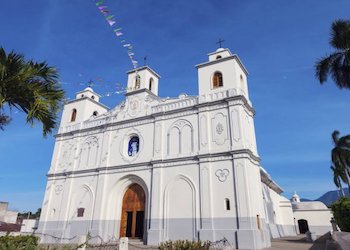Regular drug seizures near Ahuachapán’s border with Guatemala suggest the department is a transit point for cocaine and marijuana. The Mara Salvatrucha (MS13) street gang is reportedly involved in drug transport and the gang controls the local distribution of illicit narcotics within the department.
Cocaine travels by land and sea along the department’s Pacific coast, where small motor boats are used to ship the drug along rivers or to unload narcotics shipments on beaches in the coastal municipality of San Francisco Menéndez.
The MS13 is the department’s dominant gang, though a faction of the Barrio 18 Sureños also maintains a minor presence in some municipalities outside the department’s capital.

Criminal Actors
MS13: The Mara Salvatrucha (MS13) street gang has a strong presence in Ahuachapán and is reportedly active in nine of the department’s 12 municipalities. The gang is the dominant force in its main two criminal economies — extortion and local drug dealing. In the administrative capital, which goes by the same name as the department, the MS13 exerts such control that state actors may have to negotiate with gangs, via intermediaries, to enter certain areas and provide services such as health care. A prominent member of the MS13, Moris Alexander Bercián Machón, alias “El Barney,” once controlled drug distribution in the department of Ahuachapán, and the neighboring department of Sonsonate. He has also been linked to international drug shipments. The gang is also involved in arms trafficking.
Barrio 18 Sureños: The Barrio 18 street gang maintains a minor presence in Ahuachapán, notably in the municipalities of Turín, Atiquizaya, El Refugio and Tacuba. Like their counterparts the MS13, the gang primarily engages in extortion and local drug dealing. There are, however, no signs that Barrio 18 plays a part in transnational narcotics smuggling or the illicit arms trade. Barrio 18 actively recruits new members from the department’s youth, sometimes forcing children to become members.
Criminal Economies
Arms Trafficking: Ahuachapán is an entry point for illegal firearms being smuggled into El Salvador from Guatemala. The MS13 appears to be a key purchaser of illicit weapons, purportedly obtaining AK-47s and M-16s from criminal groups in Guatemala. Smugglers take advantage of unmonitored crossings on the border to move illicit weapons into the department. This suggests the existence of at least a moderate black market for illegal firearms in Ahuachapán.
Cocaine: Ahuachapán’s coast is a landing point for South American cocaine shipments, suggesting the department is part of an international cocaine smuggling route. Large stretches of the department’s coastline are not monitored by authorities. There is also evidence that cocaine is trafficked through the department into Guatemala, using overland smuggling routes. There is a documented connection between Guatemalan drug trafficking groups and their Salvadoran counterparts in Ahuachapán, as well as minor connections with the MS13. Ahuachapán is one of the main exit points for cocaine shipments that land on the Pacific coast and enter Guatemala via the department’s porous western border, but El Salvador’s modest role in regional cocaine trafficking means that profits are likely smaller compared to border areas in neighboring Guatemala.
Cannabis: Ahuachapán’s leaky border with Guatemala is a transit point for marijuana shipments entering El Salvador. Two of Ahuachapán’s municipalities were among those with the highest amount of cannabis seizures between 2013 and 2019, meaning marijuana smuggling is one of the area’s more lucrative economies. The Atiquizaya municipality is one of the main MS13 strongholds in western El Salvador and is used by the gang to distribute cannabis to the rest of the country.
Environmental Crime: Illegal logging may occur on a small scale in Ahuachapán, though there is no evidence of a significant timber extraction industry. Orange-chinned parakeets, a non-endangered bird species, have been rescued in the department. There are also reports of small-scale turtle products being trafficked in Ahuachapán. In 2015, local residents protested against deforestation in the El Chino protected area.
Human Trafficking: Human trafficking rings operate in areas near the border with Guatemala. The MS13 has a strong presence in Ahuachapán, and in some cases, gang members have attempted to force girls into sex work. In addition, Ahuachapán is a key transit point for migrants, who are vulnerable to human trafficking, but this criminal economy appears modest in the department.
Human Smuggling: We estimate around 2,500 Salvadoran migrants were returned to Ahuachapán in 2019 from the US and Mexico. Given the price of hiring a smuggler from the area (roughly $10,000), this appears to be a lucrative criminal economy, reaching into the tens of millions of dollars. Aside from Salvadorans, Ahuachapán is also an important transit point for undocumented migrants from around the world who cross the border with Guatemala on their way to the US.
Extortion: Extortion is a consistent feature of life in the department; this crime is mainly perpetrated by street gangs who target transport operators, merchants, and other economic sectors with a weekly or monthly fee.
Sources: This profile is based on a field investigation in Ahuachapán and research in San Salvador, where InSight Crime interviewed top officials from El Salvador’s anti-narcotics police (División Antinarcóticos de la Policía Nacional Civil – DAN), the mayor’s office, police officials, healthcare staff, and social workers. InSight Crime also drew from information provided by the Government of El Salvador, the Economic Ministry’s General Direction of Statistics and Censuses (Dirección General de Estadística y Censos), municipal extortion data, the United Nations Office on Drugs and Crime (UNODC), the El Salvador-based Diálogos think tank, and local press.

